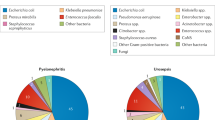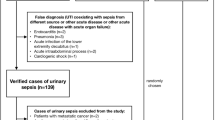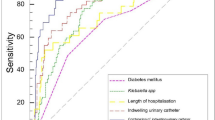Abstract
Urinary tract infection (UTI) is the most common type of bacterial infection contracted by recipients of renal allografts in the post-transplantation period. Fungi and viruses can also cause UTIs, but infections caused by these organisms are less common than those caused by bacteria. Both the lower and upper urinary tract (encompassing grafted or native kidneys) can be affected. Factors that might contribute to the development of UTIs include excessive immunosuppression, and instrumentation of the urinary tract (e.g. urethral catheters and ureteric stents). Antimicrobials are the mainstays of treatment and should be accompanied by minimization of immunosuppression when possible. The use of long-term antimicrobial prophylaxis is controversial, however, as it might increase the likelihood of infective organisms becoming resistant to treatment. There are conflicting data on the associations of post-transplantation UTI with graft and patient survival.
Key Points
-
Urinary tract infection (UTI) is the most common bacterial infection in the period after renal transplantation; the infection can develop early (within 6 months of the procedure) or late (more than 6 months after transplantation)
-
Excessive immunosuppression might be a key factor in the development of both early and late UTI; early UTI might also be caused by instrumentation of the urinary tract (e.g. urethral catheters and ureteric stents)
-
Fungal and viral infections are less common than bacterial UTIs but require active management
-
Post-transplantation UTI should be treated with antimicrobials, and by reducing immunosuppression when appropriate
-
Upper UTI (i.e. pyelonephritis) of either transplanted or native kidneys should be treated aggressively, and any underlying cause detected
-
The use of long-term antimicrobial prophylaxis is controversial and could increase the risk of bacterial resistance to treatment
-
Transplant pyelonephritis, as opposed to lower tract UTI, might be associated with decreased long-term graft function
This is a preview of subscription content, access via your institution
Access options
Subscribe to this journal
Receive 12 print issues and online access
$209.00 per year
only $17.42 per issue
Buy this article
- Purchase on Springer Link
- Instant access to full article PDF
Prices may be subject to local taxes which are calculated during checkout
Similar content being viewed by others
References
Alangaden GJ et al. (2006) Infectious complications after kidney transplantation: current epidemiology and associated risk factors. Clin Transplant 20: 401–409
Dantas SR et al. (2006) Nosocomial infections in renal transplant patients: risk factors and treatment implications associated with urinary tract and surgical site infections. J Hosp Infect 63: 117–123
Valera B et al. (2006) Epidemiology of urinary infections in renal transplant recipients. Transplant Proc 38: 2414–2415
Burgos Revilla FJ et al. (1999) Renal transplantation and urinary infection: review [Spanish]. Actas Urol Esp 23: 95–104
Prát V et al. (1985) Urinary tract infection in renal transplant patients. Infection 13: 207–210
Wagener MM and Yu VL (1992) Bacteremia in transplant recipients: a prospective study of demographics, etiologic agents, risk factors, and outcomes. Am J Infect Control 20: 239–247
Renoult E et al. (1992) Urinary tract infections during the 1st month after kidney transplantation [French]. Agressologie 33: 147–150
Senger SS et al. (2007) Urinary tract infections in renal transplant recipients. Transplant Proc 39: 1016–1017
Muñoz P (2001) Management of urinary tract infections and lymphocele in renal transplant recipients. Clin Infect Dis 33 (Suppl 1): S53–S57
Abbott KC et al. (2004) Late urinary tract infection after renal transplantation in the United States. Am J Kidney Dis 44: 353–362
Abbott KC et al. (2001) Hospitalizations for bacterial septicemia after renal transplantation in the United States. Am J Nephrol 21: 120–127
Foley RN et al. (2004) Septicemia in the United States dialysis population, 1991 to 1999. J Am Soc Nephrol 15: 1038–1045
Brennan DC et al. (2006) Rabbit antithymocyte globulin versus basiliximab in renal transplantation. N Engl J Med 355: 1967–1977
Stamm WE (1991) Catheter-associated urinary tract infections: epidemiology, pathogenesis, and prevention. Am J Med 91 (Suppl 2): S65–S71
Rabkin DG et al. (1998) Early catheter removal decreases incidence of urinary tract infections in renal transplant recipients. Transplant Proc 30: 4314–4316
Brosnahan J et al. Types of urethral catheters for management of short-term voiding problems in hospitalised adults. Cochrane Database of Systematic Reviews 2004, Issue 1. Art. No.: CD004013. 10.1002/14651858.CD004013.pub2
Anderson GG et al. (2003) Intracellular bacterial biofilm-like pods in urinary tract infections. Science 301: 105–107
Kucheria R et al. (2004) Urinary tract infections: advances and new therapies. BJU Int 93: 690–691
Wilson CH et al. Routine intraoperative ureteric stenting for kidney transplant recipients. Cochrane Database of Systematic Reviews 2005, Issue 4. Art. No.: CD004925. 10.1002/14651858.CD004925.pub2
Casale P et al. (2005) Recurrent urinary tract infection in the post-transplant reflux nephropathy patient: is reflux in the native ureter the culprit? Pediatr Transplant 9: 324–327
Pellé G et al. (2007) Acute pyelonephritis represents a risk factor impairing long-term kidney graft function. Am J Transplant 7: 899–907
Bantar C et al. (1993) Clinical, epidemiologic, and microbiologic study of urinary infection in patients with renal transplant at a specialized center in Argentina [Spanish]. Arch Esp Urol 46: 473–477
Rodman JS (1999) Struvite stones. Nephron 81 (Suppl 1): S50–S59
Goya N et al. (1997) Prevalence of urinary tract infection during outpatient follow-up after renal transplantation. Infection 25: 101–105
Dadhania D et al. (2003) Molecular signatures of urinary cells distinguish acute rejection of renal allografts from urinary tract infection. Transplantation 75: 1752–1754
John U et al. (2006) High prevalence of febrile urinary tract infections after paediatric renal transplantation. Nephrol Dial Transplant 21: 3269–3274
Krcmery S et al. (1999) Fungal urinary tract infections in patients at risk. Int J Antimicrob Agents 11: 289–291
Hirsch HH (2002) Polyomavirus BK nephropathy: a (re-)emerging complication in renal transplantation. Am J Transplant 2: 25–30
Giral M et al. (2002) Acute graft pyelonephritis and long-term kidney allograft outcome. Kidney Int 61: 1880–1886
Sobh MA et al. (1992) Impact of schistosomiasis on patient and graft outcome after kidney transplantation. Nephrol Dial Transplant 7: 858–864
Mahmoud KM et al. (2001) Impact of schistosomiasis on patient and graft outcome after renal transplantation: 10 years' follow-up. Nephrol Dial Transplant 16: 2214–2221
Van der Weide MJ et al. (2006) Lower urinary tract symptoms after renal transplantation in children. J Urol 175: 297–302
Herthelius M and Oborn H (2007) Urinary tract infections and bladder dysfunction after renal transplantation in children. J Urol 177: 1883–1886
Dunn SP et al. (1987) Pyelonephritis following pediatric renal transplant: increased incidence with vesicoureteral reflux. J Pediatr Surg 22: 1095–1099
Basiri A et al. (2006) Does pre-transplantation antireflux surgery eliminate post-renal transplantation pyelonephritis in children. J Urol 175: 1490–1492
Dharnidharka VR et al. (2007) Effects of urinary tract infection on outcomes after renal transplantation in children? Clin J Am Soc Nephrol 2: 100–106
Sadeghi M et al. (2005) Strong inflammatory cytokine response in male and strong anti-inflammatory response in female kidney transplant recipients with urinary tract infection. Transpl Int 18: 177–185
Fowlis GA et al. (1994) The cost effectiveness of combined rapid tests (Multistix) in screening for urinary tract infections. JR Soc Med 87: 681–682
Hariharan S (2006) BK virus nephritis after renal transplantation. Kidney Int 69: 655–662
Gonzalez-Michaca L et al. (2000) Percutaneous kidney biopsy, analysis of 26 years: complication rate and risk factors [Spanish]. Rev Invest Clin 52: 125–131
Naber KG et al. (2006) Section 4. In European Association of Urology Guidelines on the management of Urinary and Male Genital Tract Infections 2006, 52–63. Amsterdam: Elsevier
Vogt P et al. (1988) Ofloxacin in the treatment of urinary tract infection in renal transplant recipients. Infection 16: 175–178
Grekas D et al. (1993) Treatment of urinary tract infections with ciprofloxacin after renal transplantation. Int J Clin Pharmacol Ther Toxicol 31: 309–311
Lazinska B et al. (2005) Bacteriological urinalysis in patients after renal transplantation. Pol J Microbiol 54: 317–321
Schwab SJ et al. (1987) Renal infection in autosomal dominant polycystic kidney disease. Am J Med 82: 714–718
Jepson RG et al. Cranberries for preventing urinary tract infections. Cochrane Database of Systematic Reviews 2004, Issue 2. Art. No.: CD001321. 10.1002/14651858.CD001321.pub4
Raz R et al. (2004) Cranberry juice and urinary tract infection. Clin Infect Dis 38: 1413–1419
Raz R and Stamm WE (1993) A controlled trial of intravaginal estriol in postmenopausal women with recurrent urinary tract infections. N Engl J Med 329: 753–756
Boedeker KS and Kilzer WJ (2001) Fluconazole dose recommendation in urinary tract infection. Ann Pharmacother 35: 369–372
Siu YP et al. (2004) Successful kidney re-transplantation in a patient with previous allograft kidney tuberculosis. Transpl Infect Dis 6: 132–135
Rice JC et al. (2006) Renal allograft injury is associated with urinary tract infection caused by Escherichia coli bearing adherence factors. Am J Transplant 6: 2375–2383
Ciszek M et al. (2006) Urine cytokines profile in renal transplant patients with asymptomatic bacteriuria. Transplantation 81: 1653–1657
Valente JF et al. (2003) Comparison of sirolimus vs. mycophenolate mofetil on surgical complications and wound healing in adult kidney transplantation. Am J Transplant 3: 1128–1134
Rozanski J et al. (2005) Pretransplant nephrectomy in patients with autosomal dominant polycystic kidney disease. Transplant Proc 37: 666–668
Khosroshahi HT et al. (2006) Efficacy of high-dose trimethoprim-sulfamethoxazol prophylaxis on early urinary tract infection after renal transplantation. Transplant Proc 38: 2062–2064
Tolkoff-Rubin NE et al. (1982) A controlled study of trimethoprim-sulfamethoxazole prophylaxis of urinary tract infection in renal transplant recipients. Rev Infect Dis 4: 614–618
Kaminska W et al. (2002) Urinary tract infections caused by endemic multi-resistant Enterobacter cloacae in a dialysis and transplantation unit. J Hosp Infect 51: 215–220
Zárate G and Nader-Macias ME (2006) Influence of probiotic vaginal lactobacilli on in vitro adhesion of urogenital pathogens to vaginal epithelial cells. Lett Appl Microbiol 43: 174–180
Osset J et al. (2001) Assessment of the capacity of Lactobacillus to inhibit the growth of uropathogens and block their adhesion to vaginal epithelial cells. J Infect Dis 183: 485–491
Uehara S et al. (2006) A pilot study evaluating the safety and effectiveness of Lactobacillus vaginal suppositories in patients with recurrent urinary tract infection. Int J Antimicrob Agents 28 (Suppl 1): S30–S34
Rayes N et al. (2005) Supply of pre- and probiotics reduces bacterial infection rates after liver transplantation—a randomized, double-blind trial. Am J Transplant 5: 125–130
Lee SJ et al. (2007) Probiotics prophylaxis in children with persistent primary vesicoureteral reflux. Pediatr Nephrol 22: 1315–1320
Land MH et al. (2005) Lactobacillus sepsis associated with probiotic therapy. Pediatrics 115: 178–181
Nicolle LE et al. (2005) Infectious Diseases Society of America guidelines for the diagnosis and treatment of asymptomatic bacteriuria in adults. Clin Infect Dis 40: 643–654
Olszyna DP et al. (2001) Urine interleukin-8 is a marker for urinary tract infection in postoperative patients. Infection 29: 274–277
Boelke E et al. (2001) Urinary endotoxin excretion and urinary tract infection following kidney transplantation. Transpl Int 14: 307–310
Blazik M et al. (2005) Leukocyte phenotype and function predicts infection risk in renal transplant recipients. Nephrol Dial Transplant 20: 2226–2230
Yannaraki M et al. (2006) Urinary cytotoxic molecular markers for a noninvasive diagnosis in acute renal transplant rejection. Transpl Int 19: 759–768
Smith SD et al. (2000) Temporal changes of cytokines and nitric oxide products in urine from renal transplant patients. Kidney Int 58: 829–837
Light JA et al. (1980) Serum beta-2-microglobulin: an adjunctive monitoring test in renal transplantation. Proc Clin Dial Transplant Forum 10: 67–73
Alexopoulos E et al. (1985) Urinary tract infections after renal transplantation. Drugs Exp Clin Res 11: 101–105
Kuriyama M et al. (1991) Urinary tract infections after kidney transplantation [Japanese]. Hinyokika Kiyo 37: 1173–1179
Takai K et al. (1998) Urinary tract infections following renal transplantation. Clin Transplant 12: 19–23
Lyerová L et al. (2001) Urinary tract infection in patients with urological complications after renal transplantation with respect to long-term function and allograft survival. Ann Transplant 6: 19–20
Kass EH (1956) Asymptomatic infections of the urinary tract. Trans Assoc Am Physicians 69: 56–64
Stamm WE (1988) Protocol for diagnosis of urinary tract infection: reconsidering the criterion for significant bacteriuria. Urology 32 (Suppl 2): S6–S12
Lansang MC et al. (2006) The relationship between diabetes and infectious hospitalizations in renal transplant recipients. Diabetes Care 29: 1659–1660
Grenier J et al. (2006) Pomelo juice, but not cranberry juice, affects the pharmacokinetics of cyclosporine in humans. Clin Pharmacol Ther 79: 255–262
Kaim AH et al. (2001) PET-CT-guided percutaneous puncture of an infected cyst in autosomal dominant polycystic kidney disease: case report. Radiology 221: 818–821
Author information
Authors and Affiliations
Corresponding author
Ethics declarations
Competing interests
The authors declare no competing financial interests.
Rights and permissions
About this article
Cite this article
de Souza, R., Olsburgh, J. Urinary tract infection in the renal transplant patient. Nat Rev Nephrol 4, 252–264 (2008). https://doi.org/10.1038/ncpneph0781
Received:
Accepted:
Published:
Issue Date:
DOI: https://doi.org/10.1038/ncpneph0781
This article is cited by
-
Five compelling UTI questions after kidney transplant
World Journal of Urology (2020)
-
UTI in kidney transplant
World Journal of Urology (2020)
-
Bacterial urinary tract infection among adult renal transplant recipients at St. Paul’s hospital millennium medical college, Addis Ababa, Ethiopia
BMC Nephrology (2019)
-
Perioperative prophylaxis with ertapenem reduced infections caused by extended-spectrum betalactamase-producting Enterobacteriaceae after kidney transplantation
BMC Nephrology (2019)
-
Urinary tract infections in renal transplant recipients at a quaternary care centre in Australia
BMC Nephrology (2019)



